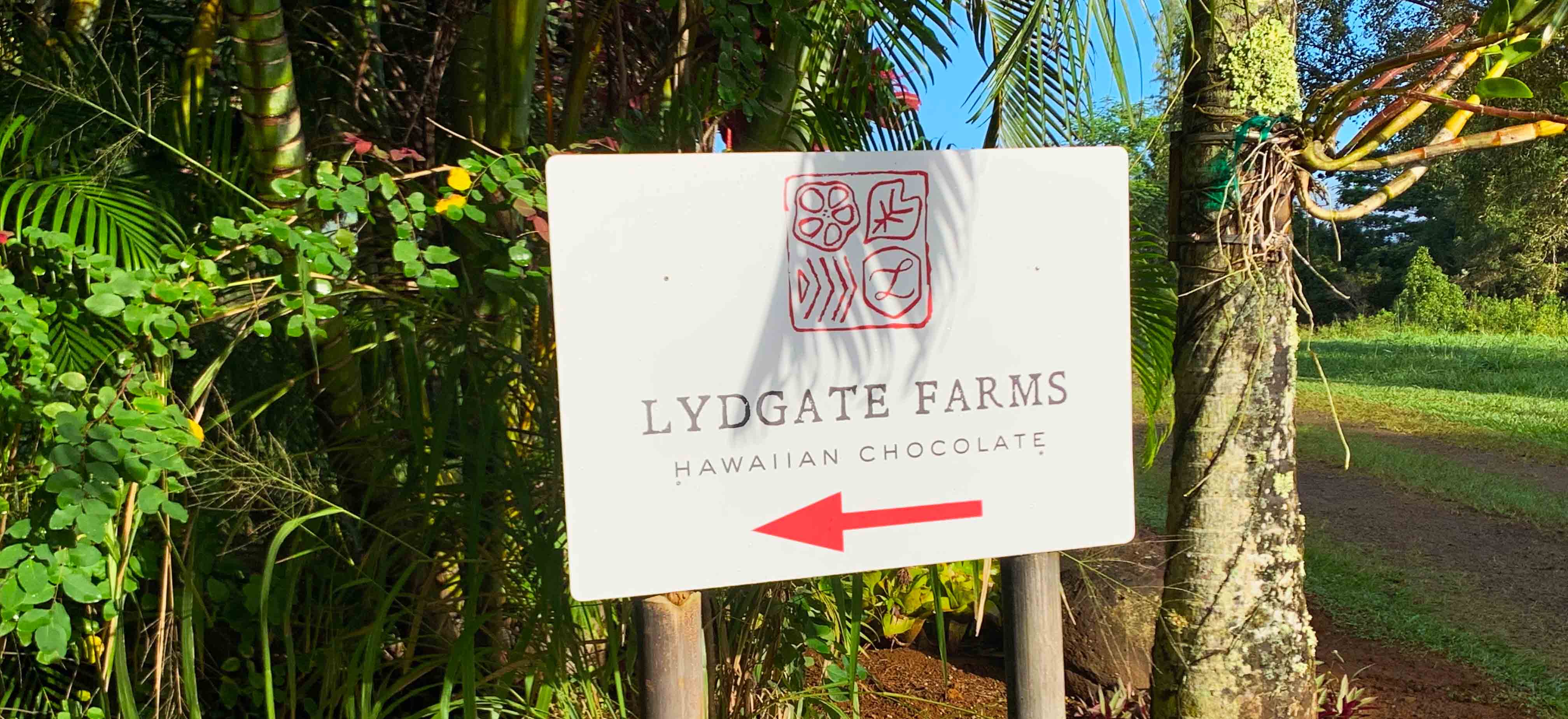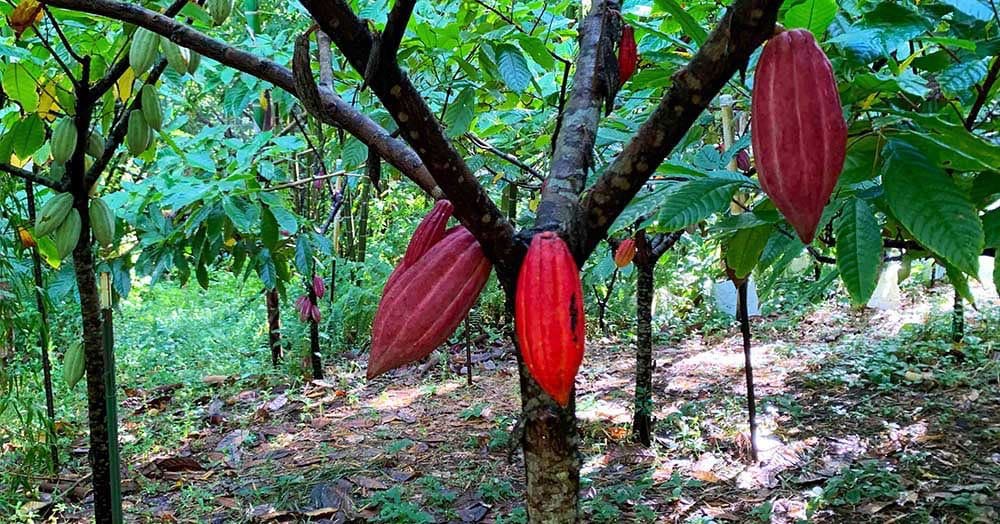So much chocolate. And fruit. And vanilla. And honey. Lydgate Farms in Kaua’i is truly the place to taste it all.
We took in a tour of the beautiful chocolate plantation thinking we’d learn about their “branch to bar” philosophy and maybe taste a bite of chocolate. We ended up with an education about Kaua’i produce and a few great stories along the way. Oh, and yes—we tasted chocolate. Lots of it.

The tour starts with a good dose of mosquito spray and your choice of umbrella, useful for protection from rain, sun, and for use as a walking stick. Our guide was Andrea, who gave up the rat race of California traffic and traded it for life as a surfing champ and chocolate pro. Her enthusiasm was contagious, starting with, “We have a blast on this tour” all the way through, “We have a ‘no chocolate left behind’ policy.”
The Song of India
Our first stop was at a clear view of the vanilla bean vines, which wrap around the base of the “Song of India” plantation trees. Here we learned that one type of insect pollinates the vanilla orchid, and that particular insect does not reside in Kaua’i! That means they hand pollinate the tricky blooms, which only open for about six hours in a single day. During the two months of the blooming cycle, plantation employees are on high alert for open blooms, ready to hand pollinate and keep the crop going.
As the story unfolds, you begin to realize why the cost of pure vanilla and vanilla bean is so high—this is not a crop to leave unattended. Once they harvest the pods, they are able to cure them in a more controlled environment, but it still takes a year.

Moving on, we learned that the numerous species of trees on the plantation offered nourishment to the colony of 20 beehives, which produce award-winning Palm Blossom Honey. Lydgate Farms has used that honey as an inclusion in its chocolate, too, producing a 70 percent dark chocolate with what they call “farm honey.” The bees apparently are particularly fond of the palm blossoms on the Foxtail Palm trees…thus, the name.
As we walked the trail, tropical fruits were picked straight from the various trees—although Andrea also came prepared with some cut samples to make it a little easier to taste in smaller bites. We went through Tahitian Lime, with a tart taste that needed the pairing of sugar cane that was handed out. We tried Longan fruit, with a soft shell to crack, a pit in the middle, and the texture of a grape—all leading to its nickname, “dragon’s eye.”
Next was a cornucopia (well, a plastic container) full of star fruit, passionfruit, papaya, guava, rambutan, and chiku, with plenty to taste repeatedly. Education continued, of course, as we learned a little about each fruit.
Guide to Fruit
- Star fruit is a winter fruit in the islands. If choosing your own at a farmers market, look for an orange-yellow color, not green, because this fruit will not ripen after picking. The entire fruit is edible, including the seeds and skin.
- Passionfruit is also known as lilikoi, and it’s commonly found in some of the island sweets. If you see a sign for POG, that means it’s a combination of passionfruit, orange, and guava—and it’s an excellent choice for your shave ice. Passionfruit is full of edible seeds, but the rind is bitter, so avoid it. Choose one that is yellow with brown spots or a shriveled look, because, according to Andrea, “the uglier it gets, the sweeter it tastes.” She also advises, “If you see lilikoi cheesecake, get it!”
- Papaya is a fruit that is OK if it’s a bit under ripe. You can eat the skin, but it’s bitter. The fruit also has some functional benefits—it’s reportedly good for digestion, as well as for burns and skin injuries.
- Guava should be pale yellow “with a little give, like a ripe avocado,” and, yes, you can eat the seeds.
- Rambutan is probably the most interesting fruit, and it needs to be a nice bright red before you pick it, because it won’t ripen once it’s harvested. Best advice is to open it up and, “Treat it like nature’s little Jell-O shot.”
- The Chiku is an exotic fruit indigenous to India, with the taste of a cinnamon pear. Eat the skin, but don’t eat the seeds.
The Ultimate Cacao Experience
All this before we even got to the chocolate! Trust me, though, we got there—first with one of those experiences you don’t get too often in a lifetime: eating the fruit of the cacao pod right off the tree (yes, chocolate grows on trees). Andrea took her machete, sliced one down, opened it up, and passed it around.
As we dug in to the pods with our fingers, our education continued. The shells are as much as two inches thick. In the wild, propagation is dependent on “furry animals” who open up the fruit and eat the pulp but not the beans—leaving them to spread around and create new trees. At Lydgate Farms, they harvest cacao every two-three weeks, year round.
 The processing starts with fermentation, working with 800-1,000 pods at a time. It’s all done by hand, moving wet beans from a wooden box to drying beds where they are exposed to the Hawaiian air. The beans are then roasted, producing chocolate covered with a light shell called a “nib,” which is separated and used separately. From there, the chocolate inside is processed with sugar and any inclusions (such as sea salt or honey), and—while this is a simplified analysis of the process—you have completed the “branch to bar” cycle.
The processing starts with fermentation, working with 800-1,000 pods at a time. It’s all done by hand, moving wet beans from a wooden box to drying beds where they are exposed to the Hawaiian air. The beans are then roasted, producing chocolate covered with a light shell called a “nib,” which is separated and used separately. From there, the chocolate inside is processed with sugar and any inclusions (such as sea salt or honey), and—while this is a simplified analysis of the process—you have completed the “branch to bar” cycle.
Chocolate For Every Preference
Of course, no chocolate tour can be complete without that final tasting, and Lydgate Farms does it right, offering a selection of their chocolates along with some for comparison. The blind tasting is fun, as we go through the steps of smelling each selection, letting the chocolate melt on our tongue, and identifying the notes of cherries, honey, bourbon, and so on found in the different chocolates. You come away understanding that chocolate really does taste different depending on where the beans are grown and how they are processed.
Chocolate also, at least according to Andrea, has 30 different mood elevating properties—meaning that if you weren’t enjoying your trip to Hawaii before the trip to Lydgate Farms, you have an abundance of reasons to feel great about it now!
Get our recipe for making your own Pure Vanilla Extract here.
Photos by Paul K. Logsdon.
Find links to other stories from our visit to Hawaii here.
Partial promotional benefits provided by Tasting Kaua’i and Lydgate Farms.


You must be logged in to post a comment.